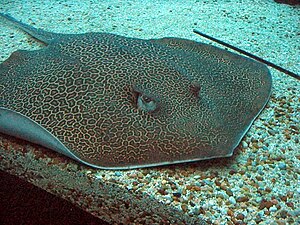Himantura undulata
| Himantura undulata | ||||||||||||
|---|---|---|---|---|---|---|---|---|---|---|---|---|

Himantura undulata |
||||||||||||
| Systematics | ||||||||||||
|
||||||||||||
| Scientific name | ||||||||||||
| Himantura undulata | ||||||||||||
| Bleeker , 1852 |
Himantura undulata is a species of the stingray family(Dasyatidae). It lives widespread in the Indo-Pacific and occurs near the coast on soft soil between the latitudes 30 ° north and 24 ° south. Its distribution area extends from the Bay of Bengal north to the Ryūkyū Islands , to New Guinea and the Torres Strait and south to the coast of Northern Australia. A previously suspected occurrence in the western Indian Ocean has not been confirmed.
features
Himantura undulata , including the long tail, can reach a maximum length of up to 4.10 meters. The diamond-shaped body disc is a maximum of 1.4 meters wide. The muzzle is pointed. Together with the pectoral fins that are extended forward and fused with the head, it forms an obtuse angle. The body disc is slightly longer than it is wide, the tail very long and slender. In juvenile fish, if undamaged, it can be 3.5 times as long as the body disc. The total length of the fish at sexual maturity is usually 85 to 90 centimeters. On the top of the tail there is a spine but no dorsal fin. The pelvic fins are small. The eyes are small, the distance between the eyes and the injection holes directly behind them is large. The mouth is narrow, the lip furrows poorly developed, the outer nostrils long and narrow. There is an enlarged spike on the shoulder region, which is often surrounded by smaller thorns. There are no large thorns on the upper midline of the tail.
The top of the body and tail of adult specimens is yellowish or brownish and marked with a dense pattern of leopard-like dark rings. Young fish are gray-brown in color and have large black spots, the distances between which are only slightly narrower than the diameter of the largest spots. On the part of the tail that is close to the body, they have a row of dark spots on each side.
Like all stingrays, Himantura undulata is ovoviviparous .
literature
- PR Last & LJV Compagno: Dasyatidae. in Kent E. Carpenter & Volker H. Niem: The Living Marine Resources of the Western Central Pacific. FAO Species Identification Guide for Fishery Purposes. Volume 3 Batoid fishes, chimaeras and Bony fishes part 1 (Elopidae to Linophrynidae), Rome, 1998, ISBN 92-5-104302-7
Web links
- Himantura undulata on Fishbase.org (English)
- Himantura undulata inthe IUCN 2013 Red List of Threatened Species . Posted by: Rigby, C., 2011. Retrieved November 3, 2013.